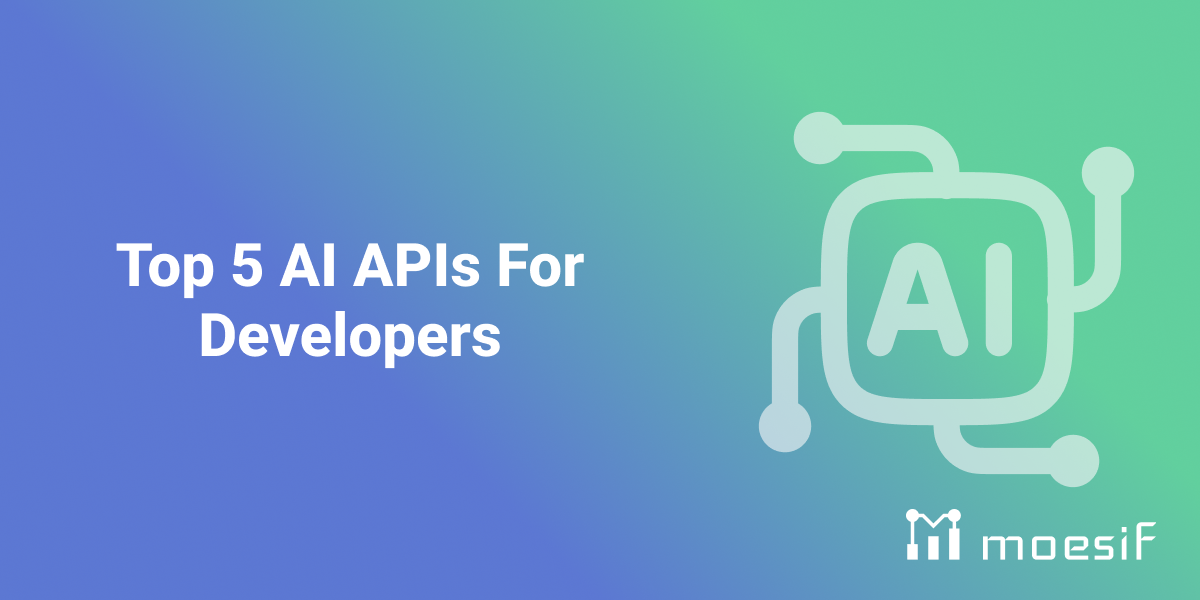Top 5 AI APIs For Developers

Artificial Intelligence (AI) technology has been transforming industries and our day-to-day lives alike. Its undeniable impact has led to significant effort and investment into making AI more accessible to everyone, everywhere. Open-source AI technology and AI APIs are two examples of our commitment to AI democratization.
AI APIs democratize AI by providing access to pre-trained AI models, even for developers without extensive machine learning expertise. These standardized interfaces connect applications to powerful AI capabilities like speech recognition, natural language processing (NLP), image analysis, and data-driven predictions.
This blog explores the leading AI APIs, their advantages, and how to select the ideal one for your projects.
Table of Contents
- What are AI APIs?
- Types of AI APIs
- Top AI APIs for Developers
- Benefits of Using AI APIs
- Choosing the Right AI API
- Security and Performance Considerations
- Best Practices for Working with AI APIs
- Conclusion

What are AI APIs?
Artificial Intelligence APIs connect powerful AI capabilities with the applications you build. They provide a way for your software to interact with and leverage pre-built machine learning models, often hosted in the cloud. Think of them as ready-to-use AI building blocks that you can integrate into your projects.
These APIs abstract away the complexities of AI. Developers can focus on implementing features without needing deep machine learning expertise. For example, you can build an app that can generate images, analyze images, and identify objects in images. You can add functionalities like natural language understanding, sentiment analysis, and facial recognition to your application with just a few lines of code. AI APIs handle the heavy lifting, processing data, and returning results that your application can then use.
For pre-trained models, many artificial intelligence APIs have customization options as well. These options can fine-tune models based on specific use cases or datasets. This involves providing additional data to the API that adapts the model’s parameters to better suit the use case. Some providers also allow you to build custom models.
This accessibility democratizes AI and makes it available to a wider range of developers and businesses. It accelerates development, reduces costs, and opens doors to innovation that otherwise requires significant AI research and development.
Brief History and Evolution of AI APIs
AI APIs did not appear overnight; their development mirrors the broader evolution of artificial intelligence. Initially, AI APIs relied on rule-based systems, where programmers defined explicit behavior rules. While useful for specific tasks, these systems lacked the adaptability and learning capabilities of modern AI.
The advent of machine learning in the 1990s marked a significant turning point. AI APIs began using machine learning algorithms that learn from data, such as decision trees and support vector machines, improving performance over time. This shift allowed them to tackle more complex tasks, opening doors to new applications.
In the 2010s, deep learning techniques revolutionized AI APIs with neural networks inspired by the human brain’s structure. Frameworks like TensorFlow and PyTorch allowed developers to use these models for AI tasks such as natural language processing (for example, Google Translate’s advancements) and computer vision (self-driving cars owe much to this).
Today, cloud infrastructure powers AI API accessibility. Companies like Google, Amazon, and Microsoft offer cloud-based AI APIs. Developers have easy access to advanced machine learning models and computational resources now more than ever. Thanks to AI services like AWS SageMaker, Google Cloud AI, and Microsoft Azure Machine Learning, AI APIs can scale automatically to process vast amounts of data and serve millions of users.
Types of AI APIs
Before we talk about the top AI APIs, let’s briefly discuss the types of AI APIs and capabilities they offer.
Natural Language Processing (NLP) APIs
Natural Language Processing (NLP) allows machines to process and respond to human language. Using NLP APIs, developers can integrate language processing capabilities into their applications. These applications can analyze text, detect sentiment, summarize articles, translate languages, and respond to voice commands. We see these features across many of the digital tools we use daily. For example, chatbots that handle customer inquiries, voice assistants that manage schedules, and translation tools that connect people across the globe.
NLP APIs power many modern applications, such as virtual assistants like Siri and Alexa. These applications demonstrate how NLP is transforming how we interact with technology. Tasks like ordering a pizza, booking a flight, or controlling smart home devices have become as simple as speaking a command.
While NLP has advanced significantly, machines don’t truly “understand” language in the way humans do. They process and generate text based on patterns in data. NLP APIs can perform tasks like sentiment analysis, summarization, and translation with varying accuracy, depending on the context and complexity of a specific language.
Computer Vision APIs
Computer Vision allows machines to interpret and understand visual information from the world around them. Computer Vision APIs can process images and videos to identify and classify objects, detect and recognize faces, and even interpret scenes and emotions.
Providers of computer vision APIs typically categorize them based on the use case. For example, an image recognition API supports detecting objects in the image. A facial recognition API, for example, allows machines to identify individuals based on their unique facial features. Many smart devices vendors support unlocking your device through this feature. Same goes for security systems that don’t allow someone to enter unless their facial scan matches an entry in a database of authorized personnel.
Another powerful feature is optical character recognition (OCR). It allows machines to extract text from images and documents. Using OCR, you can convert a handwritten note into a digital document or extract information from a scanned invoice.
Top AI APIs for Developers
Comprehensive AI platforms offer a suite of machine learning APIs with pre-trained models. They scale automatically on the cloud with varying degrees of customization options. Developers can easily find an AI API that suits their use case and integrate it, worrying about building the infrastructure from scratch or scalability.
Here are five top comprehensive AI platforms for you to consider:
OpenAI
OpenAI is known for their sophisticated large language models (LLMs) capable of advanced natural language processing. OpenAI has APIs for natural language processing, code generation, creating content generation, and more. You can use these APIs to build applications that understand and generate human-like text.
Google Cloud AI
Google Cloud AI provides AI services like vision, language, and structured data processing. They offer a number of APIs across various use cases. All of them are powered by Google Cloud’s scalable infrastructure and robust documentation.
Microsoft Azure Cognitive Services
Azure AI Services, formerly Azure Cognitive Services, provides a suite of APIs for computer vision, speech, language, and decision-making. Azure AI Services focuses on ease of use and integration. Some popular APIs include Speech service APIs and the Face API.
IBM Watson
A pioneer in AI, IBM Watson offers APIs for natural language processing, speech recognition, and discovery, such as Watson Assistant and Watson Discovery. Their robust and accurate services are suitable enterprise-level applications and developers alike.
Clarifai
Clarifai provides AI and machine learning services in advanced computer vision, natural language, and generative AI technologies. Their API supports integrating video recognition, image recognition, and advanced natural language processing features. The API has SDKs for various programming languages so developers of different backgrounds can integrate AI into their apps.
Benefits of Using AI APIs

Integrating AI APIs into your applications can transform your work and interactions with technologies. Let’s discuss the two key advantages.
Increased Efficiency
- Rapid Development: You can leverage pre-trained AI models and ready-to-use functionalities to reduce development time and focus on core features.
- Task Automation: AI-powered apps can automate mundane and repetitive tasks, freeing your team to focus on strategic and creative work.
- Scalability: AI APIs can handle growing data volumes and complex processes. This ensures smooth operations as your business expands. However, scalability also depends on the underlying infrastructure and application design. Without proper support from these components, you may not enjoy the full benefits of using AI APIs for scalability.
Enhanced Capabilities
- Complex Task Handling: AI-enhanced apps can perform tasks like natural language processing and image analysis that humans alone may find challenging or impossible.
- Intelligent Interactions: You can build applications that understand human language, analyze visual data, and make data-driven predictions.
- Personalized Experiences: AI-driven insights allow you to fine-tune user experiences. You get better engagement and satisfaction, both of which positively impacts your product growth.
Incorporating AI APIs into your development toolkit helps you stay current with trends. Moreover, you gain a competitive edge, optimized processes, and deliver delightful user experiences.
Choosing the Right AI API
Let’s discuss two crucial aspects we recommend you consider when choosing an AI API.
Evaluating API Features and Pricing
Identify the type of AI functionality your project needs, such as NLP or video analysis. Try to exactly pinpoint the types of services you need and whether the vendor provides them. For example, let’s say you need sentiment analysis features. Despite an API offering natural language processing, it may not provide sentiment analysis. Choose an API that aligns with your requirements and has a proven track record.
Examine the pricing model carefully. Some APIs offer pay-as-you-go plans, while others use subscription models. Consider any usage limits or additional fees and evaluate cost-effectiveness relative to your budget.
Ensure the API can handle your current and future data volumes. Look for performance metrics or benchmarks to assess its ability to process large datasets and manage concurrent requests efficiently.
Integration and Support
Evaluate how easily the API integrates with your existing systems and applications. Look for clear documentation, SDKs, and code examples. Test integration in a development environment before full deployment.
Assess the level of support the API vendor provides. Comprehensive documentation, tutorials, and responsive customer support provide immense value during development and troubleshooting. They guide you through the integration process, help you understand the API’s functionalities, and offer solutions when you encounter challenges. Community forums and user groups can also offer helpful resources.
Ensure the API supports the programming languages and frameworks you prefer. This compatibility will save time and effort during integration.
Security and Performance Considerations
Data security and performance optimization drive successful AI integration. Rising cyber threats and growing user expectations demand active measures to protect data and ensure seamless performance. Addressing these concerns directly prevents data breaches, legal complications, and customer dissatisfaction.
Data Security and Compliance
As AI gets more adoption, we observe companies adopting data security and regulatory measures with a non-negotiable mindset. This speaks volumes about the collective concern for transparency and risk mitigation while we employ AI in sensitive areas.
Let’s discuss this topic in more detail and some key aspects we recommend you consider.
Robust Security Measures
Encryption serves as the first line of defense in protecting data. Implement end-to-end encryption to secure data both at rest and in transit. Even if someone intercepts, this safeguard makes sure that the data remains unreadable to unauthorized parties.
Define strict access controls to limit who can access the API and the data it processes. Consider role-based access control (RBAC). It assigns permissions based on a user’s role within the organization so that users have minimum necessary permissions, reducing the risk of accidental or malicious misuse.
Use strong authentication methods such as OAuth 2.0 or API keys to ensure that only authorized users can interact with the API. Multi-factor authentication (MFA) significantly reduces the risk of unauthorized access by requiring more than one form of verification.
Conduct regular security audits and vulnerability assessments to identify and fix potential weaknesses in the API infrastructure. Staying proactive helps prevent security breaches before they occur.
Regulatory Compliance
When deploying AI solutions globally, ensure compliance with global regulations like GDPR (General Data Protection Regulation) in Europe, HIPAA (Health Insurance Portability and Accountability Act) in the U.S., and CCPA (California Consumer Privacy Act). Each regulation defines specific requirements for how the system must handle, store, and process personal data.
Ensure that the API vendor maintains transparency about their data handling practices. Understand where they store data (data residency), how it’s processed, and whether third parties have access. This transparency helps avoid legal complications and builds trust with users.
Employ techniques like data anonymization and minimization to protect sensitive information. By anonymizing data, you reduce the risk of exposing personal information, even in the event of a breach.
Data Policies
Scrutinize the API vendor’s data policies to understand how they might use your data beyond the primary application. Ensure that the vendor does not use your data for purposes that conflict with your organization’s policies, such as selling data to third parties. If the API vendor shares data with third parties, make sure these parties also comply with relevant regulations and maintain high security standards.
Understand the vendor’s data retention policies. Determine how long they store data and the processes in place for secure data deletion when no longer needed.
Performance Optimization
A high-performing API ensures a better user experience and efficient operations. Pay attention to the following considerations when you choose an AI API:
Response Time and Throughput
Without low latency in API response times, you cannot deliver a smooth user experience, especially in real-time applications like voice recognition or interactive chatbots. Aim for an API that consistently delivers sub-second response times.
High throughput ensures that the API can handle a large number of requests simultaneously without degrading performance. Evaluate the API’s capacity to manage peak loads, and consider load balancing solutions if necessary.
Implement monitoring tools to track the API’s performance metrics in real-time. These tools can alert you to potential bottlenecks and allow you to adjust quickly to maintain optimal performance.
Data Handling Efficiency
The API should use efficient algorithms that can process data quickly, particularly when dealing with large datasets. Evaluate how the API handles data processing tasks such as batch processing versus real-time streaming, depending on your needs.
Consider the API’s ability to manage concurrent requests without slowing down. This includes managing thread pools effectively and ensuring that resource allocation scales with demand.
Rate limiting helps prevent any single client from overwhelming the API with too many requests at once. This ensures consistent performance across all users, especially during peak times.
Caching and CDN
Caching frequently accessed data can significantly reduce the API’s response time. Regularly review and adjust caching strategies to match changing usage patterns to maintain optimal performance.
A content delivery network (CDN) distributes API responses across multiple geographically dispersed servers. By serving content from the server closest to the user, a CDN reduces latency and speeds up data delivery.
Best Practices for Working with AI APIs
After you’ve chosen an API for your use case, you want to maximize its utility. For that, you must understand the limitations and stay current with developments. Here are some best practices we recommend you follow:
Understanding AI API Limitations
AI APIs, while powerful, have limitations that you must recognize and address to build reliable applications.
AI models may inherit biases from their training data and produce errors, especially with edge cases or unfamiliar data. Be proactive in identifying and mitigating these issues, such as through data augmentation or re-training with diverse datasets.
Test the API’s accuracy and reliability across different data types and use cases before full implementation. Identifying potential weaknesses early can prevent issues later.
Opt for APIs that offer transparency and insights into their decision-making processes. Especially, regulated industries uphold explainability as a crucial factor for compliance and trust.
Staying Up-to-Date with AI API Developments
The AI landscape evolves rapidly. If you stay informed, you can confidently leverage the best tools and techniques.
Regularly check for API updates and new features, which may include performance improvements, added functionalities, and bug fixes. Subscribe to vendor newsletters or follow their release notes to stay informed.
Choose vendors with a strong commitment to research and development. Evaluate their track record in delivering updates and innovations to ensure long-term support and access to cutting-edge AI capabilities.
Select APIs that can adapt to your evolving business needs. Ensure the API can scale and grow with your application as your requirements change.
Additional Best Practices
- Continuously monitor and log API usage to identify issues early and optimize performance over time.
- Utilize well-documented APIs and engage with community support forums. This helps you troubleshoot and learn from others’ experiences.
Conclusion
AI APIs have transformed the way we build applications. Developers are building more efficient, intelligent, and innovative apps and systems. Whether you want to automate tasks, enhance user experiences, or gain a competitive edge, AI APIs offer a powerful toolkit to achieve your goals.
As AI continues to advance and dominate our lives, we’ll see more push for AI democratization. We’ll see more and more businesses and developers adopt AI. So if you have the next big idea, it wouldn’t be wrong to consider how AI can fit into that. But incorporating AI into your product alone doesn’t set you up for success. You must continuously monitor, understand, and conduct research to tackle the challenges that lie ahead.
That’s where Moesif comes in with a comprehensive suite of powerful analytics and monitoring tools. Moesif has also built robust monetization features from the ground up so that you can grow your AI product.
Sign up today for a free trial today to try it yourself, no credit card required.





